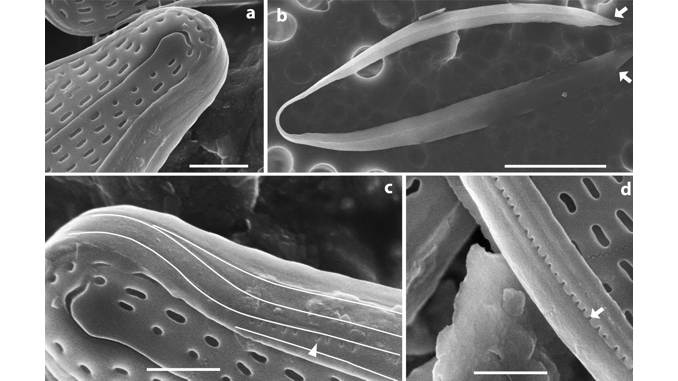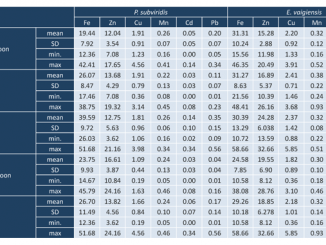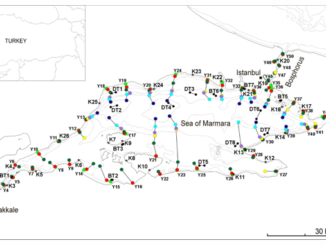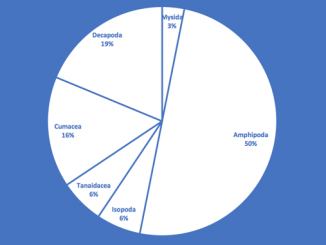
Paper category: Original research paper
Corresponding author: Catherine Riaux-Gobin (catherine.gobin@univ-perp.fr)
DOI: 10.1515/ohs-2020-0012
Received: 09/09/2019
Accepted: 05/12/2019
Full text: here
Citation (APA style): Oceanological and Hydrobiological Studies, Volume 49, Issue 2, Pages 132–139, eISSN 1897-3191, ISSN 1730-413X, DOI: https://doi.org/10.1515/ohs-2020-0012.
Abstract
Epizoic diatom communities were studied on four turtle species (Chelonia mydas L., Eretmochelys imbricata L., Lepidochelys olivacea Eschscholtz and Dermochelys coriacea Vandelli) from the Eastern Caribbean, the Equatorial West Atlantic and the South Pacific. In the present study, we focused on one taxon of Navicula Bory de Saint-Vincent, described here as a new taxon, which was found on seven individuals of Dermochelys coriacea and one individual of Lepidochelys olivacea in French Guiana. The new Navicula taxon was found neither on Chelonia mydas (83 specimens examined) nor Eretmochelys imbricata (13 specimens examined). Furthermore, the new taxon appears to have a restricted biogeography, as so far it has only been reported from French Guiana. A species of Navicula is reported for the first time as a supposedly exclusive epizoic taxon. Navicula dermochelycola sp. nov. is characterized in detail; its ultrastructure is described and compared with other members of Navicula.
References
Bjorndal, K.A. (1996). Foraging ecology and nutrition of sea turtles. In P.L. Lutz & J.A. Musick (Eds.), The biology of sea turtles (pp. 199–232). CRC press Boca Raton, London, NY.
Cleve, P.T. & Grunow, A. (1880). Beiträge zur Kenntniss der arctischen Diatomeen. Kongliga Svenska Vetenskaps-Akademiens Handlingar 17(2): 1–121, 7 pls.
Denys, L. (1997). Morphology and taxonomy of epizoic diatoms (Epiphalaina and Tursiocola) on a sperm whale (Physeter macrocephalus) stranded on the coast of Belgium. Diatom Research 12: 1–18. DOI: 10.1080/0269249X.1997.9705398.
Denys, L. & De Smet, W.H. (2010). Epipellis oiketis (Bacillariophyta) on harbour porpoises from the North Sea Channel (Belgium). Polish Botanical Journal 55: 175–182.
Denys, L. & Van Bonn, W. (2001). A second species in the epizoic diatom Epipellis: E. heptunei sp. nov. In R. Jahn, J.P. Kociolek, A. Witkowski & P. Compère (Eds.), Lange-Bertalot-Festschrift. Studies on diatoms. Dedicated to Prof. Dr. Dr. h.c. Horst Lange-Bertalot on the occasion of his 65th birthday (pp. 167–176). A.R.G. Gantner Verlag K.G., Ruggel,
Dodge, K.L., Logan, J.M. & Lutcavage, M.E. (2011). Foraging ecology of leatherback sea turtles in the Northwest Atlantic determined through multi-tissue stable isotope analyses. Marine Biology 158: 2813–2824.
Fernandes, M.F. & Calixto-Feres, L. (2012). Morphology and distribution of two epizoic diatoms (Bacillariophyta) in Brazil. Acta Botanica Brasilica 26: 836–841. DOI: 10.1590/s0102-33062012000400012.
Finkbeiner, E.M., Wallace, B.P., Moore, J.E., Lewison, R.L., Crowder, L.B. et al. (2011). Cumulative estimates of sea turtle bycatch and mortality in USA fisheries between 1990 and 2007. Biological Conservation 144: 2719–2727. DOI: 10.1016/j.biocon.2011.07.033.
Frankovich, T.A., Ashworth, M.P., Sullivan, M.J., Theriot, E.C. & Stacy, N.I. (2018). Epizoic and apochlorotic Tursiocola species (Bacillariophyta) from the skin of Florida Manatees (Trichechus manatus matirostris). Protist 169(4): 539–568.
Frankovich, T.A., Ashworth, M.P., Sullivan, M.J., Veselá, J. & Stacy, N.I. (2016). Medlinella amphoroidea gen. et sp. nov. (Bacillariophyta) from the neck skin of Loggerhead sea turtles (Caretta caretta). Phytotaxa 272(2): 101–114. DOI : 10.11646/phytotaxa.272.2.1.
Gasse, F. (1986). East African diatoms: Taxonomy, ecological distribution. Bibliotheca Diatomologica 11: 1–201.
Germain, H. (1981). Flore des diatomées - Diatomophycées - eaux douces et saumâtres du Massif Armoricain et des contrées voisines d'Europe occidentale. Collection Faunes et Flores Actuelles. Société Nouvelle des éditions Boubée, Paris. 444 pp.
Gómez, F., Wang, L. & Lin, S. (2018). Morphology and molecular phylogeny of epizoic araphid diatoms on marine zooplankton, including Pseudofalcula hyalina gen. & comb. nov. (Fragilariophyceae, Bacillariophyta). Journal of Phycology 54(4): 557–570.
Holmes, R.W. (1985). The morphology of diatoms epizoic on cetaceans and their transfer from Cocconeis to two new genera, Bennettella and Epipellis. British Phycological Journal 20: 43–57. DOI: 10.1080/00071618500650061.
Holmes, R.W. & Nagasawa, S. (1995). Bennettella constricta (Nemoto) Holmes and Bennettella berardii sp. nov. (Bacillariophyceae: Chrysophyta) as observed on the skin of several cetacean species. Bulletin of the National Science Museum, Series B (Botany), Tokyo 21(1): 29–43.
Holmes, R.W., Nagasawa, S. & Takano, H. (1993). The morphology and geographic distribution of epidermal diatoms of the Dalls porpoise (Phocoenoides dalli True) in the Northern Pacific Ocean. Bulletin of the National Science Museum, Series B (Botany), Tokyo 19(1): 1–18.
Kociolek, P. (2011). Navicula salinarum. In: Diatoms of North America. Retrieved September 07, 2019, from https://diatoms.org/species/navicula_salinarum
Krammer, K. & Lange-Bertalot, H. (1986). Bacillariophyceae. 1. Teil: Naviculaceae In H. Ettl, J. Gerloff, H. Heynig & D. Mollenhauer (Eds.). Süsswasserflora von Mitteleuropa, Band 2/1. Gustav Fisher Verlag, Jena. 876 pp.
Krasske, G. (1941). Die Kieselalgen des chilenischen Küstenplanktons. Archiv für Hydrobiologie 38: 260–287.
Kützing, F.T. (1844). Die kieselschaligen Bacillarien oder Diatomeen. Nordhausen. 152 pp., 30 pls.
Lange-Bertalot, H. (2001). Navicula sensu stricto, 10 genera separated from Navicula sensu lato, Frustulia. Diatoms of Europe 2: 1–526.
Majewska, R., Kociolek, J.P., Thomas, E.W., De Stefano, M., Santoro, M. et al. (2015). Chelonicola and Poulinea, two new gomphonemoid diatom genera (Bacillariophyta) living on marine turtles from Costa Rica. Phytotaxa 233(3): 236–250. DOI : 10.11646/phytotaxa.233.3.2.
Nelms, S.E., Duncan, E.M., Broderick, A.C., Galloway, T.S., Godfrey, M.H. et al. (2015). Plastic and marine turtles: A review and call for research. ICES Journal of Marine Science. DOI: 10.1093/icesjms/fsv165.
Nemoto, T. (1956). On the diatoms of the skin film of whales in the northern Pacific. The Scientific Reports of the Whales Research Institute, Tokyo 11: 97–132.
Patrick, R.M. & Reimer, C.W. (1966). The Diatoms of the United States exclusive of Alaska and Hawaii. V. 1 Monographs of the Academy of Natural Sciences of Philadelphia 13.
Pavlov, A., Jovanovska, E., Wetzel, C.E., Ector, L. & Levkov, Z. (2016). Freshwater Mastogloia (Bacillariophyceae) taxa from Macedonia, with a description of the epizoic M. sterijovskii sp. nov. Diatom Research 31(2): 85–112. DOI: 10.1080/0269249X.2016.1157376.
Potapova, M. & Kociolek, P. (2011). Navicula rostellata. In: Diatoms of North America. Retrieved September 07, 2019, from https://diatoms.org/species/navicula_rostellata
Riaux-Gobin, C. & Witkowski, A. (2012). Small-sized and discoid species of the genus Cocconeiopsis (Bacillariophyta) on Holothuria atra (Juan de Nova, Mozambique Channel). Phytotaxa 54(1): 43–58. DOI: 10.11646/phytotaxa.54.1.5.
Riaux-Gobin, C., Witkowski, A., Kociolek, P., Ector, L., Chevallier, D. et al. (2017). New epizoic diatom (Bacillariophyta) species from sea turtles in the Eastern Caribbean and South Pacific. Diatom Research 32(1): 109–125. DOI: 10.1080/0269249X.2017.1299042.
Romagnoli, T., Totti, C., Accoroni, S., De Stefano, M. & Pennesi, C. (2014). SEM analysis of the epibenthic diatoms on Eudendrium racemosum (Hydrozoa) from the Mediterranean Sea. Turkish Journal of Botany 38: 566–594. DOI: 10.3906/bot-1305-52.
Rushforth, S. & Spaulding, S. (2010). Navicula capitatoradiata. In Diatoms of North America. Retrieved September 07, 2019, from https://diatoms.org/species/navicula_capitatoradiata
Sazima, C., Grossman, A. & Sazima, I. (2010). Turtle cleaners: reef fishes foraging on epibionts of sea turtles in the tropical Southwestern Atlantic, with a summary of this association type. Neotropical Ichthyology 8: 187–192.
Taasen, J.P. (1975). Navicula fucicola sp. nov., a diatom living in the apical slit of Fucus vesiculosus L. (Phaeophyceae). Sarsia 59(1): 1–6. DOI: 10.1080/00364827.1975.10411282.
Takano, H. (1983). New and rare diatoms from Japanese marine waters. XI. Three new species epizoic on copepods. Bulletin Tokai Regional Fisheries Research Laboratory 111: 23–37.
Wetzel, C.E., Van de Vijver, B. & Ector, L. (2010). Luticola deniseae sp. nov. A new epizoic diatom from the Rio Negro (Amazon hydrographic basin). Vie et milieu-Life and Environment 60(3): 177–184.
Wilcox, C., Puckridge, M., Schuyler, Q., Townsend, K. & Hardesty, D. (2018). A quantitative analysis linking sea turtle mortality and plastic debris ingestion. Scientific Reports 2018; 8: Article 12536. DOI: 10.1038/s41598-018-30038-z.
Wuchter, C., Marquardt, J. & Krumbein, W.E. (2003). The epizoic diatom community on four bryozoan species from Helgoland (German Bight, North Sea). Helgoland Marine Research 57: 13–19. DOI: 10.1007/s10152-002-0117-z.
Yaghmour, F., M. Al Bousi, M., Whiiington-Jones, B., Pereira, J., Garcia-Nunez, S. & Budd, J. (2018). Marine debris ingestion of green sea turtles, Chelonia mydas (Linnaeus, 1758) from the eastern coast of the United Arab Emirates. Marine Pollution Bulletin 135: 55–61. DOI: 10.1016/j.




Bądź pierwszy, który skomentuje ten wpis